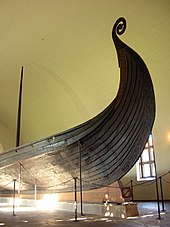I. 서론
필자는 최근 돌궐의 위치 연구에 여념이 없다. 돌궐의 위치가 기존의 사학계에서 주장하는 Gokturk가 아니라 프랑스 북부 지역에 있다는 확신에 근거한 것이다. 그 확신은 거란의 별종인 실위지역이 지금의 덴마크 반도지역이나 그 북쪽으로 추론 되는바, 실위에 관련 신당서 문서에는 실위의 서쪽에 돌궐이 있고, 실위의 동쪽에는 흑수말갈이 있다고 기록했기 때문이다.
돌궐은 흉노의 별종이라 한다. 흑수말갈은 최근에 필자가 쓴 글에서 모스크바 지역의 흑수에서 출발한 흑수말갈은 이 지역에서 출발하여 흑해지방까지 진출하고 미구에는 지금의 판노니아지방으로 이동한 마자르족 즉 말갈이 아닌가 한다고 추정했다. 따라서 돌궐은 실위의 서쪽이므로, 북해의 서쪽이나 발트해 북쪽에서 본 서쪽으로 바이킹 지역으로 추정되는 노르웨이 지역이나 삭슨족이나 켈트족이 사는 영국의 지역으로 추정된다.
그런데 최근 쓴 글 ' 돌궐은 북해의 삭슨족인가?'라는 글에서, 스코틀랜드나 아일랜드의 켈트족은 돌궐이 아니라는 추정이 되었으며, 독일 북부 해변의 Saxons족과 Britain으로 이동한 Saxons족은 프랑스 북부 지역에 약탈하는 행위를 한 역사가 있으나, 이들은 숙신으로 불리는 종족으로 후에 여진족이 되는 민족으로 추정되었다.
즉 흉노의 별종이라는 돌궐의 정체에는 다소 거리가 있는 모양새이다. 흉노는 역사적으로 고구려의 전신이랄 수 있으며, 서양사에서 훈족으로 대표되는 고구려의 모습이다. 따라서 흉노의 별종이라면, 우리 역사에 등장하는 한민족의 모습을 찾을 수 있을 것으로 기대한다. 그리하여 혹시나 하는 심정으로 바이킹을 연구하게 되었다. 만약 바이킹의 연구에서 이러한 점이 발견된다면, 바이킹의 선조들이 돌궐일 가능성이 매우 높은 것이다.
II. 바이킹의 문화
바이킹의 문화를 알아 보기 전에, 왜 바이킹들이 흔히 생각하듯이 유럽의 각 지역 해변을 약탈하는 모습을 보였는지 궁금하다. 이러한 모습은 바이킹 전에도 Saxons족, Angles족, Jutes족 등에서 볼 수 있었으나, 특히 바이킹시대에 더 유별난 이유를 기록에서 알아 보고자 한다.
1. 바이킹의 활동 동기
바이킹 자료에서 이러한 활동의 동기는 첫째, 프랑크왕국의 Charlemagne왕의 지나친 기독교화 추구에 있다고 하는 설이 있다. Charlemagne왕은 Saxons족과 30여년 이상 전쟁을 하였다. 그리하여, 그 반작용으로 그랬는지 몰라도 4500여명을 한꺼번에 몰살 시키는 잔인한 일을 했다. (Massacre of Verden). 핑계는 기독교인이 되지 않으면 죽는다는 것을 Saxons족에게 강요한 것으로 서양사는 말한다. 그러나 Charlemagne는 아바르칸국을 점령하면서 아바르인들을 모두 죽였다고 서양사는 전하고 있는 것을 보면, 살생의 욕구가 큰 잔인한 왕이라 판단된다. 이를 포장하기 위해 기독교 전파라는 너울을 씌운 것으로 필자는 판단한다.
참고로 Charlemagne시기(768-814)의 당나라 역사에서는 당 대종(762-779), 당 덕종(779-805)과 당 헌종(805-820)의 시기이다. 당 대종과 덩 덕종은 문치의 역사를 보이고 있고, 당 헌종은 절도사들을 통제, 정벌하는 치적을 보여 준다. Charlemagne는 문치의 치적과 정벌의 치적이 있는데, 당 대종, 당 덕종, 당 헌종의 치적을 합쳐 놓은 모습이다. 당 헌종 시기에는, 평로 치청 절도사인 고구려 유민인 이정기의 난(781)이 있은 후 그 후손들이 세운 제나라(781-819)를 멸망시켰는데, Charlemagne왕이 멸망 시킨 아바르칸국(805년 멸망)이 이러한 제나라로 추정된다. 당 헌종은 아들이 19살로 요절하자, 불교와 도교에 빠져갔다고 역사는 말한다. 프랑크왕국이나 당나라나 모두 환관의 발호, mayor of palace의 발호로 왕권이 약화되고 멸망하게 된다.
즉 이러한 설명은 SAXONS족이 바이킹으로 이어진다는 가설이 성립한다. 그러나 바이킹의 문화를 보면 이러한 설명은 설득력이 약하다.
다른 설명은 당시에 바이킹이 활동할 시기에 다른 주위지역의 약함에 있다는 주장이다. 당시 서유럽에 이들의 자유로운 항해를 막을 조직화된 수군의 능력이 부족했다는 것이다. 바이킹은 강이나 바다를 통해 주로 활동하였다. 그리고 서로마제국의 멸망으로 무역루트의 수익성이 나빠졌다는 이유도 언급된다. (아래 자료 참조) (그러나 이후 활발한 바이킹과 Varagians의 무역활동을 고려할 때, 수익성의 악화 이유는 설득력이 없다고 본다. )
바이킹이전에도 Jutes족, Saxons족, Angles족, Jutes족이후 등장한 Danes족 등도 스칸디나비아로부터 유럽으로의 약탈과 정착을 했으나, 단지 바이킹시대부터 기록되었을 뿐이라 한다. 그래서 바이킹이 팽창함에 따라, 지역의 자원이 부족하게 되어, 그러한 현상이 있었을 수 있다고 역사학자들은 믿는다 한다. (아래 자료 참조)
"The motives driving the Viking expansion are a topic of much debate in Nordic history. one common theory posits that Charlemagne "used force and terror to Christianise all pagans", leading to baptism, conversion or execution, and as a result, Vikings and other pagans resisted and wanted revenge.[59][60][61][62][63] Professor Rudolf Simek states that "it is not a coincidence if the early Viking activity occurred during the reign of Charlemagne".[59][64] The penetration of Christianity into Scandinavia led to serious conflict dividing Norway for almost a century.[65]
Another explanation is that the Vikings exploited a moment of weakness in the surrounding regions. England suffered from internal divisions and was relatively easy prey given the proximity of many towns to the sea or to navigable rivers. Lack of organised naval opposition throughout Western Europe allowed Viking ships to travel freely, raiding or trading as opportunity permitted. The decline in the profitability of old trade routes could also have played a role. Trade between western Europe and the rest of Eurasia suffered a severe blow when the Roman Empire fell in the 5th century.[66] The expansion of Islam in the 7th century had also affected trade with western Europe.[67]
Raids in Europe, including raids and settlements from Scandinavia, were not unprecedented and had occurred long before the Vikings arrived. The Jutes invaded the British Isles three centuries earlier, pouring out from Jutland during the Age of Migrations, before the Danes settled there. The Saxons and the Angles did the same, embarking from mainland Europe. The Viking raids were, however, the first to be documented in writing by eyewitnesses, and they were much larger in scale and frequency than in previous times.[68]
Vikings themselves were expanding; although their motives are unclear, historians believe that scarce resources were a factor.[69] "
(source : Vikings, Wikipedia, 인용출처 : 필자의 다음블로그, 카테고리, Vikings)
이제 서론은 그만하고 바이킹의 문화에 대해 본격적으로 살펴 보자
2. 바이킹의 무기
바이킹의 무기는 아래 사진과 같이 큰 방패를 이용하고, 긴 창을 쓴다.

축제에서의 바이킹의 무기 (자료 : 위키피디아)
그런데, 진서 동이열전에 마한에 대한 묘사가 이와 유사하다. 즉 마한사람들이 활, 방패, 창, 큰 방패를 잘 쓴다고 아래 자료에서 말한다. 상기 사진에서는 활에 대한 언급이 없으나, 아래 Danes족의 사냥에서, 활 및 석궁을 이용했다고 기술하였다. 즉 활도 바이킹이 이용하였다는 것이며, 이는 마한의 기록과 매우 일치한다.
필자는 마한이 유럽 중부와 이태리반도라 추정했다. 동쪽 프랑스지역에 있었던 Audui족이나 유럽 중부에 있던 Helveti(해족?)으로 추정되는, 백두산 10국의 하나인 해두국이 마한의 거수국이었다고 한다. 따라서 백두산 (=몽블랑산) 10국 중의 하나인 주나국, 조나국 (Juteland, 덴마크지역) 등도 마한의 거수국일 가능성이 있다. 즉 이들이 스칸디나비아 반도에 가까우므로 바이킹과 연관이 있을 수 있다고 본다. 그리고 북부여 지역으로 돌아간 두막루(Danes족)가 덴마크지역으로 AD 500년경 (동부여가 망한 후 일부 세력이 이 지역으로 옮김) 이동했으므로, 이들도 9세기부터 나타나는 바이킹과 연관이 있을 수 있다. 즉 바이킹과 마한의 연결 가능성이 충분히 있다는 것이다.
| -[그 나라 사람들은] 활·방패·창·큰 방패를 잘 쓰며, |
| 비록 남과 다투거나 전쟁을 할 때에도 굴복한 상대를 서로 귀하게 여긴다.
[출처] 진서 동이열전(晉書 東夷列傳) : 마한 馬韓|작성자 sololife
|
(인용출처 : 필자의 네이버 블로그, 카테고리, 삼한, 공유자료)
3. 바이킹의 Appearances
바이킹 여성들의 치장은 부자(Jarls계층)들은 비싼 실크옷을 입으며, 브로우치, 혁대버클, 목걸이, 팔찌 등 보석을 치장하기 좋아한다고 아래 기록된다. 이러한 보석 가공은 Norse에 특이하다고 했다. 반면, 손가락 반지나 귀걸이 등은 슬라브족에서나 보이며 바이킹들은 전혀 하지 않는다 한다. 평민들(Karls계층)도 같은 모습이나 비교적 덜 비싼 것을 한다고 한다. (아래 자료 참조)
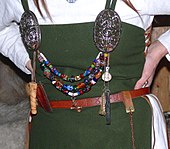
Typical jewellery worn by women of the Karls and Jarls: ornamented silver brooches, coloured glass-beads and amulets
"The three classes were easily recognisable by their appearances. Men and women of the Jarls were well groomed with neat hairstyles and expressed their wealth and status by wearing expensive clothes (often silk) and well crafted jewellery like brooches, belt buckles, necklaces and arm rings. Almost all of the jewellery was crafted in specific designs unique to the Norse (see Viking art). Finger rings were seldom used and earrings were not used at all, as they were seen as a Slavic phenomenon. Most Karls expressed similar tastes and hygiene, but in a more relaxed and inexpensive way.[119][126] "
(source : Vikings, Wikipedia, 인용출처 : 필자의 다음블로그, 카테고리, Vikings)
아래 마한인의 자료에서는 일부 비슷하나 다소 차이가 있다. 즉 마한인은 금, 은, 비단(실크), 모직물 따위를 귀중하게 여기지 않고, 구슬을 귀중하게 여겨 옷에 꿰어 차기도 하고 (브로우치), 또는 머리를 장식하거나, 귀에 달기도 한다. 귀걸이나 반지는 바이킹들은 하지 않고, 슬라브인들이 한다고 했다. 바이킹은 혁대 버클을 사용한다 했는데, 필자가 한국에서 고등학교 졸업시만 해도 모교표시의 혁대버클을 졸업선믈로 받았는데, 이것이 언제부터 시작한 관습인지는 모르겠다.
| [그 나라의] 풍속에는 금·은·비단·모직물 따위를 귀중하게 여기지 않고, |
| 구슬을 귀중하게 여겨서 옷에 꿰어 차기도 하고 또는 머리를 장식하거나 귀에 달기도 한다.
[출처] 진서 동이열전(晉書 東夷列傳) : 마한 馬韓|작성자 sololife
|
(인용출처 : 필자의 네이버 블로그, 카테고리, 삼한, 공유자료)
4. 바이킹의 Runestones (룬문자가 새겨져 있는 돌)
중앙아시아의 Gokturk (기존 사학계에서 말하는 돌궐)에도 돌에 새겨진 비문이 있다 했는데, 바이킹에도 룬문자가 새겨진 돌들이 많이 발견된다. (아래 사진 참조)
Main article: Runestone

The Lingsberg Runestone in Sweden
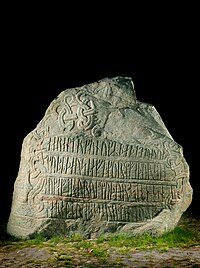
Runic inscriptions of the larger of the Jelling Stones in Denmark
Two types of Norse runestones from the Viking Age
"The Norse of the Viking Age could read and write and used a non-standardised alphabet, called runor, built upon sound values. While there are few remains of runic writing on paper from the Viking era, thousands of stones with runic inscriptions have been found where Vikings lived. They are usually in memory of the dead, though not necessarily placed at graves. The use of runor survived into the 15th century, used in parallel with the Latin alphabet.
(번역) 바이킹시대의 스칸디나비아인들은 읽고 쓰고, 소리에 기초한 룬문자를 이용했다. 바이킹시대로부터 종이에 쓰여진 유물은 매우 적고, 주로 바위에 새겨진 수천개의 돌들이 바이킹이 사는 곳에서 발견된다. 이것들은 죽은 사람들을 기리기 위한 것인데, 꼭 묘지에 있는 것은 아니었다. 룬문자는 15세기에 살아 남아 라틴문자와 함께 이용되었다.
The majority of runic inscriptions from the Viking period are found in Sweden and date from the 11th century. The oldest stone with runic inscriptions was found in Norway and dates to the 4th century, suggesting that runic inscriptions pre-date the Viking period. Many runestones in Scandinavia record the names of participants in Viking expeditions, such as the Kjula runestone that tells of extensive warfare in Western Europe and the Turinge Runestone, which tells of a war band in Eastern Europe. Other runestones mention men who died on Viking expeditions. Among them are around 25 Ingvar runestones in the Mälardalen district of Sweden, erected to commemorate members of a disastrous expedition into present-day Russia in the early 11th century. Runestones are important sources in the study of Norse society and early medieval Scandinavia, not only of the Viking segment of the population.[92][citation needed]
(번역) 바이킹시대의 룬문자 새긴 돌들(=runestones)의 대부분은 11세기부터 스웨덴에서 발견된다. Runestones의 가장 오래된 것은 노르웨이에서 발견되었으며, 4세기것으로 보인다. 이는 룬문자 새기는 일이 바이킹시대 이전에 있었다는 말이다. 스칸디나비아의 많은 runestones은 바이킹원정대에 참여한 사람들의 이름을 적고 있다. 예들어 Kjula runestone은 서유럽에서의 긴 전쟁을 말하고 있고, Turinge Runestone은 동유럽에서의 전쟁집단에 대해 말한다. 다른 runestones은 바이킹 원정대에서 사망한 남자들을 언급한다. 그들중에는 스웨덴 Malardalen 구역의 25개 Ingvar runestones이 있는데, 이것들은 11세기 초에 현재의 러시아로의 피해가 컸던 원정대의 구성원들을 기리기 위해 세워졌다. Runestones은 스칸디나비아 사회 뿐만 아니라, 그들중 바이킹의 부분, 그리고 중세초기의 스칸디나비아 연구에 있어서 중요한 자료이다.
The Jelling stones date from between 960 and 985. The older, smaller stone was raised by King Gorm the Old, the last pagan king of Denmark, as a memorial honouring Queen Thyre.[93] The larger stone was raised by his son, Harald Bluetooth, to celebrate the conquest of Denmark and Norway and the conversion of the Danes to Christianity.
(번역) Jelling stones(현재 덴마크 중동부지역의 runestones)은 960-985년시기에 해당한다. 더 오래된, 보다 작은 stone이 덴마크의 마지막 전통종교의 왕, Gorm the Old왕에 의해 세워졌는데, 이는 여왕 Thre를 추모하기 위한 것이었다. 그의 아들 Harald Bluetooth에 의해 더 큰 stone이 세워졌는데, 이는 덴마크와 노르웨이 정복을 기념하기 위해서이고 Danes가 기독교로 개종한 것을 기념하기 위한 것이다.
It has three sides: one with an animal image, one with an image of the crucified Jesus Christ, and a third bearing the following inscription:
King Haraldr ordered this monument made in memory of Gormr, his father, and in memory of Thyrvé, his mother; that Haraldr who won for himself all of Denmark and Norway and made the Danes Christian.[94]
(번역) Stone은 3가지 면이 있는데, 하나는 동물그림이고, 다른 하나는 십자가에 못박힌 예수를 그린 것이고, 세번째는 아래와 같은 내용을 담은 것이다. :Haraldr왕은 그의 아버지, Gormir, 그리고 그의 어머니 Thyrve를 기념하기 위하여, 그리고 그가 모든 덴마크지역과 노르웨이 지역을 확보한 것, 그리고 Danes족을 기독교인이 되게 한 것을 기념하기 위해서 이 비석을 세우라고 지시했다.
Runestones attest to voyages to locations such as Bath,[95] Greece,[96] Khwaresm,[97] Jerusalem,[98] Italy (as Langobardland),[99] Serkland (i.e. the Muslim world),[100] England[101] (including London[102]), and various places in Eastern Europe. Viking Age inscriptions have also been discovered on the Manx runestones on the Isle of Man."
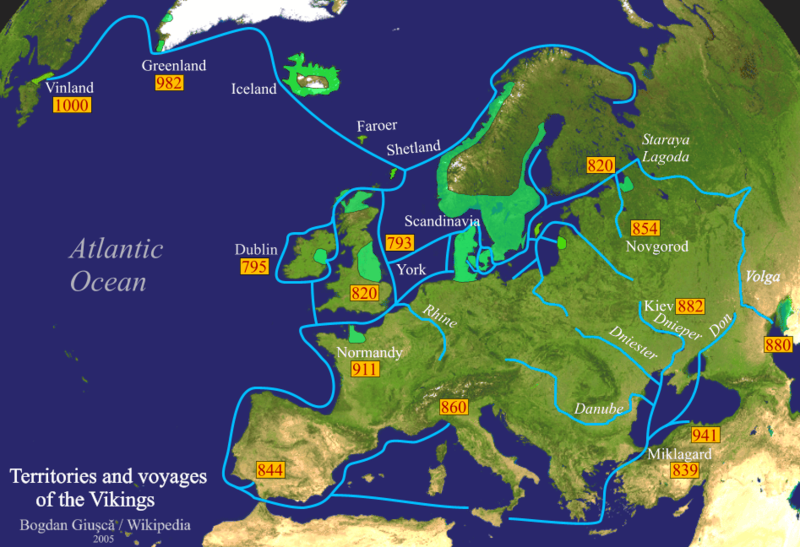
바이킹 활동지역 및 영토 (자료 : 위키피디아)
(번역) Runestones은 Bath (Britain의 서남부지역에 있는 도시, 로마제국시 spa를 지었다 함), 그리스, Khwaresm(호레즘), 예루살렘, 이탈리아(Langobardland), Serkland (land of Saracen), England(런던 포함), 그리고 동유럽의 여러 지역을 여행한 것을 확인해준다. 바이킹시대의 inscriptions은 Isle of Man지역 (Britain의 서쪽 섬들)의 Manx runestones에서도 발견되었다.
(source : Vikings, Wikipedia, 인용출처 : 필자의 다음블로그, 카테고리, Vikings)
룬문자로 돌에 새겨 넣는 것은 중앙아시아의 Gokturk문화와 유사하다. 필자는 Gokturk가 고구려가 아닌가 추정했다. 즉 바이킹의 이런 문화가 고구려 계통인 흉노의 문화라면, 바이킹이 홍노의 별종인 돌궐의 가능성이 매우 높다는 것이다. 그리고 바이킹의 돌에 새긴 정보는 바이킹들의 활동지역을 파악하는데 귀중한 정보를 제공하고 있다. 발틱해, 지중해, 북해, 러시아, 그리고 중앙아시아 호레즘까지 진출하지 않은 곳이 없을 정도이다. 이들의 활동경로를 보면 발틱해 동쪽의 varangians도 같은 바이킹임을 알 수 있다. 필자는 볼가불가리아가 발해의 일부 보로국이 아닌가 했다. 즉 이 바이킹의 활동 시기는 발해 시기에 해당한다. 따라서 발해가 바이킹의 활동을 포함한 것이 아닌가 조심스러운 추정도 하게 된다. 그래서 해동성국이라 하지 않았나 한다. 그리고 이들이 고려를 건국한 왕건의 해상세력일 수 있다는 생각이 든다.
바이킹세력의 활동이 많아진 것이 우연히 프랑크의 Charlemagne이후 시기라 했는데, Charlemagne (당 헌종 시기)는 고구려의 유민들이 세운 제나라로 판단되는 아바르칸국을 점령하고 그 유민들을 모두 죽이는 잔임함을 보였다 한다. 그래서 이들과 관련있는 고구려 유민들이 세운 발해의 세력, 즉 바이킹의 세력이 프랑크 왕국 등 지역을 약탈하지 않았을까 하는 추측도 해본다.
5. 바이킹의 매장 풍습
Burial sites
See also: Norse funeral and Ship burial
"There are numerous burial sites associated with Vikings throughout Europe and their sphere of influence—in Scandinavia, the British Isles, Ireland, Greenland, Iceland, Faeroe Islands, Germany, The Baltic, Russia, etc. The burial practices of the Vikings were quite varied, from dug graves in the ground, to tumuli, sometimes including so-called ship burials.
(번역) 바이킹이 활동했던 유럽과 그 영향지역 - 스칸디나비아, British isles, 아일랜드, 그린란드, 아이슬란드, Faroe islands, 독일, 발틱해, 러시아 등 - 에 많은 매장지가 있다. 바이킹의 매장 풍습은 꽤 다양한데, 땅을 파고 무덤을 만드는 것부터, 때로는 Ship burials이라 불리는 것을 포함한 Tumuli 등에 이르기까지의 다양한 양상이다.
According to written sources, most of the funerals took place at sea. The funerals involved either burial or cremation, depending on local customs. In the area that is now Sweden, cremations were predominant; in Denmark burial was more common; and in Norway both were common.[103]
(번역) 기록된 자료에 의하면, 모든 장례식은 바다에서 행해진다. 장례식은 매장하거나 화장을 포함하는데, 지역 관습에 따라 다르다. 지금의 스웨덴지역에서는 화장이 주를 이루었고, 덴마크에서는 매장이 더 보편적이었으며, 노르웨이에서는 두가지 형태가 모두 보편적이었다.
(source : Vikings, Wikipedia, 인용출처 : 필자의 다음블로그, 카테고리, Vikings)
위의 봉분 (Burial Mounds) 사진에서 보는 것처럼, 두막루가 있던 지역인 덴마크에서는 한민족의 매장문화인 봉분문화와 더 유사한 모습을 보이고 있다.
6. 바이킹의 순장 문화
"The Jarls were the aristocracy of the Viking society. They were wealthy and owned large estates with huge longhouses, horses and many thralls. The thralls did most of the daily chores, while the Jarls did administration, politics, hunting, sports, visited other Jarls or were abroad on expeditions. When a Jarl died and was buried, his household thralls were sometimes sacrificially killed and buried next to him, as many excavations have revealed.[121] "
(번역) Jarls은 바이킹 사회의 귀족계급이다. 그들은 부유하며, 거대한 longhouses의 부동산과 말들 그리고 많은 노예들을 소유하였다. 노예들은 모든 일상생활의 일을 담당했으며, 반면 Jarls은 행정, 정치, 사냥, 스포츠, 다른 Jarls 방문, 또는 해외 원정 등의 일을 했다. 한사람의 Jarl이 사망하고 묻히면, 그의 가구의 노예들은 때때로 희생되어 주인 곁에 묻힌 것이 많은 발굴에서 드러난다.
(source : Vikings, Wikipedia, 인용출처 : 필자의 다음블로그, 카테고리, Vikings)
즉 순장문화가 있었다는 것이다. 이 또한 한민족 문화의 특성이다.
7. 바이킹의 스포츠 : 사냥 (덴마크)
"Hunting, as a sport, was limited to Denmark, where it was not regarded as an important occupation. Birds, deer, hares and foxes were hunted with bow and spear, and later with crossbows. The techniques were stalking, snare and traps and par force hunting with dog packs."
(번역) 스포츠로서의 사냥은 덴마크 지역에 제한되며, 이 지역에서는 사냥은 주요한 직업으로 인식되지 않았다. 새, 사슴, 토끼, 여우 등이 활과 창, 후에는 석궁으로 사냥되었다. 사냥기술은 몰이, 올가미, 덫, 사냥개 등이 이용되었다.
(source : Vikings, Wikipedia, 인용출처 : 필자의 다음블로그, 카테고리, Vikings)
사냥은 과거 한민족에서는 활쏘기 등의 군사훈련의 목적도 있었고, 왕들의 소일거리로도 행해졌다. 그런데 스칸디나비아 지역에서는 덴마크에서만 사냥이 스포츠로서 이루어졌다는 것이다. 이역시 덴마크 지역이 한민족과 연관성이 매우 깊다는 것을 말해 준다고 본다. 바이킹이 덴마크에서 출발하여 노르웨이 등으로 확장되어 간 것이 아닌가 한다.
8. 바이킹의 종교
바이킹의 종교에 대한 자료는 별로 없다. 다만 비기독교인이라는 것과 기존의 전통적인 신앙을 강하게 지키려는 자세가 있어 노르웨이 지역의 기독교화가 매우 큰 저항에 부딪혔다는 기록을 본다. 아래 자료는 스웨덴의 Uppsala지역의 성스러운 나무(주목나무)라는 11세기 후반의 기록을 보며, 그 단편을 보고자 한다. 아래 자료를 보면, 성스러운 나무 옆에, 조그만 샘에 인간을 희생양으로 하는 인신공양의 모습을 말하고 있다. 그리고 이러한 모습은 인도유럽인의 말 (horse)을 제물로 바치는 의식을 언급하며, 기독교에 강력히 반발하는 기록을 아래 보여 준다.
"Sacred tree at Uppsala
From Wikipedia, the free encyclopedia
Jump to navigationJump to search
The sacred tree at Uppsala was a sacred tree located at the Temple at Uppsala, Sweden, in the second half of the 11th century. It is not known what species it was. Older sources have described it as an ash tree, but Frits Läffler [sv] have suggested that it was a yew tree.[1][2]
It is even more sparsely documented than the famous temple by which it stood. In the 1070s, the writer of a scholium in Adam of Bremen's Gesta Hammaburgensis ecclesiae pontificum explained:
Near that temple is a very large tree with widespread branches which are always green both in winter and summer. What kind of tree it is nobody knows. There is also a spring there where the pagan are accustomed to perform sacrifices and to immerse a human being alive. As long as his body is not found, the request of the people will be fulfilled.[3]
The description of the tree and the location of a well nearby are reminiscent of the evergreen Yggdrasil, which stood above the Well of Urd, and it is possible that the Swedes consciously had created a copy of the world of their Norse gods at Uppsala.[4]
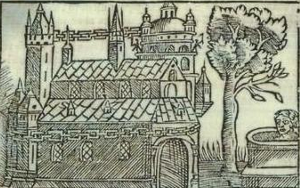
The later Icelandic source Hervarar saga contains a description of how the tree was used in the pagan rites, concerning an event taking place only a few years after the scholium was written. It is in reference to the ancient Indo-European ritual of horse sacrifice:
Svein, the King's brother-in-law, remained behind in the assembly, and offered the Swedes to do sacrifices on their behalf if they would give him the Kingdom. They all agreed to accept Svein's offer, and he was then recognized as King over all Sweden. A horse was then brought to the assembly and hewn in pieces and cut up for eating, and the sacred tree was smeared with blood. Then all the Swedes abandoned Christianity, and sacrifices started again. They drove King Ingi away; and he went into Västergötland.[5]
(source : Sacred tree at Uppsla, Wikipedia, 인용출처 : 필자의 티스토리 블로그, 카테고리, Norse)
상기 나무를 성스럽게 하는 의식과 인신공양의 모습 또는 동물을 제물로 바치는 모습은 한민족의 종교의식과 유사하다. 마한에서도 '소도' 라는 성지를 만들어 놓고, 죄인이 그곳으로 도망가도 잡지 못했었는데, 소도에 큰 나무가 있다는 기록이 상기 성스러운 나무를 연상케 한다.
"또 별읍을 설치하여 그 이름을 ‘소도’라 하는데, 큰 나무를 세우고 방울과 북을 매단다. "
[출처] 진서 동이열전(晉書 東夷列傳) : 마한 馬韓|작성자 sololife
(인용출처 : 필자의 네이버 블로그, 카테고리, 삼한, 공유자료)
9. 바이킹의 일상 생활
바이킹의 일상생활 모습에서 한민족과의 공통점을 찾아 보자.
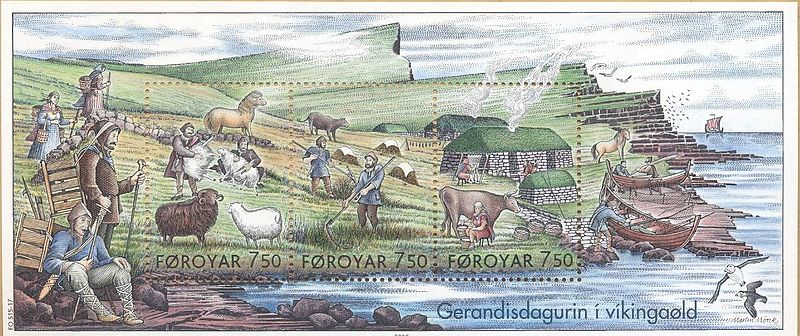
Everyday life in Viking Age (source : Wikipedia)
1) 지게의 이용
상기 그림은 바이킹시대의 일상생활이라고 위키피디아에 실린 그림이다. 그런데 가축이 많은 모습과 지게를 매고 있는 모습이 눈에 띤다. 그런데 마한의 모습에서도 지게를 매고 작업한 아래 내용이 등장한다. 등가죽을 뚫고 구멍에 큰 밧줄을 꿰는 모습은 다소 과장된 것이 아닌가 한다. 지게를 사용하는 문화로 해석할 수 있다.
마한인들은 가축을 길러도 말이나 소를 탈 줄 모르고, 그저 의식의 희생물로 쓰기 위해 키운다는 기록이 있다.(아래 기록 참조) 즉 말을 타고 다니는 유목민 보다는 반농 반목의 문화라는 것이다. 상기 그림도 유사한 모습으로 보인다.
또한 위의 바이킹의 종교 항목에서 그들은 말(Horse)를 제물로 바치는 의식을 고수하며, 기독교화에 저항했다고 하였다. 즉 마한의 말(horse)에 대한 취급과 동일한 것을 보여 준다. 다시 말하면, 바이킹과 마한은 기마민족이 아니라 해양세력이라는 것을 의미한다.
| 국가에 부역이 있거나 성황城隍을 수축할 적에 |
| 용감하고 건강한 젊은이는 모두 등가죽을 뚫고 그 구멍에 큰 밧줄을 꿰어, ** |
| 막대기로 그 줄을 흔들며 하루 종일 소리를 지르면서 힘껏 일하는데, |
| [이를] 아프게 여기지 않는다.
[출처] 진서 동이열전(晉書 東夷列傳) : 마한 馬韓|작성자 sololife
|
| 남자들은 머리를 틀어묶고 상투를 드러내놓으며, 베로 만든 도포를 입고 짚신을 신는다. |
| [그 사람들의] 성질은 용감하고 굳세다.
[출처] 진서 동이열전(晉書 東夷列傳) : 마한 馬韓|작성자 sololife
|
소나 말을 탈 줄 모르기 때문에 가축을 기르는 것은 단지 장사지내는 데 쓰기 위해서이다.
[출처] 진서 동이열전(晉書 東夷列傳) : 마한 馬韓|작성자 sololife
(인용출처 : 필자의 네이버 블로그, 카테고리, 삼한, 공유자료)
2) 상투와 유사한 Suebian Knot
상기 마한의 자료에 상투를 언급하고 있다. 한민족의 전형적인 모습이다.
그런데 바이킹의 지역인 스웨덴에서 유래한 Suebian (필자는 선비족으로 추정)들이 Suebian Knot라는 머리를 묶어 매는 머리스타일을 한다는 기록이 있다. (아래 자료 참조). 이것이 마한의 상투가 변형된 것이 아닌가 한다.
"The Suebian knot (German: Suebenknoten) is a historical male hairstyle ascribed to the tribe of the Germanic Suebi. The knot is attested by Tacitus in his 1st century AD work Germania, found on contemporary depictions of Germanic peoples, their art, and bog bodies.

Hair of bog body Dätgen Man (Germany)
(자료 : Suebian Knot, wikipedia, 인용출처 : 필자의 다음 블로그, 카테고리, Suebi)
3) 장기판 놀이
또한 바이킹들의 소일거리로 Board games, dice games를 하는데, 서양의 Chess와 유사하지만, 또한 동양의 장기판 게임과 같은 놀이를 한다고 아래 기술된다. 그리고 돈이나 값이 나가는 것으로 내기를 한다는 것이다. 이러한 내용이 Runestones에도 나타나고, 그들의 전설을 전하는 sagas에도 언급된다고 한다. 돌이나 나무 또는 동물뼈로 움직이는 말들을 만드는 모습을 보면 매우 오래된 전통의 놀이로 해석된다. 그래서 우리의 문화와 유사하여 공통점으로 뽑아 보았다.
"Both archaeological finds and written sources testify to the fact that the Vikings set aside time for social and festive gatherings.[148][149][150]
Board games and dice games were played as a popular pastime at all levels of society. Preserved gaming pieces and boards show game boards made of easily available materials like wood, with game pieces manufactured from stone, wood or bone, while other finds include elaborately carved boards and game pieces of glass, amber, antler or walrus tusk, together with materials of foreign origin, such as ivory. The Vikings played several types of tafl games; hnefatafl, nitavl (Nine Men's Morris) and the less common kvatrutafl. Chess also appeared at the end of the Viking Age. Hnefatafl is a war game, in which the object is to capture the king piece—a large hostile army threatens and the king's men have to protect the king. It was played on a board with squares using black and white pieces, with moves made according to dice rolls. The Ockelbo Runestone shows two men engaged in Hnefatafl, and the sagas suggest that money or valuables could have been involved in some dice games.[148][150] "
(source : Vikings, Wikipedia, 인용출처 : 필자의 다음블로그, 카테고리, Vikings)
이것으로 바이킹의 문화를 통한 한민족과의 유사성 검토를 마치고자 한다. 우리는 많은 면에서 공통점을 찾은 것으로 판단한다. 즉 흉노의 별종으로 불리는 돌궐이 바이킹일 수 있다는 것이다. 그리고 이들은 프랑크족이나 영국인들에게 Danes로 불려진다는 것이다. (아래 자료 참조) 덴마크란 명칭도 Danes와 관련이 있고, 필자는 이들이 500년경 북부여 지역인 덴마크지역으로 이동한 동부여의 일부 세력이라 추정했다. 즉 바이킹이 한민족과 관련이 깊을 수 있고, Danes의 후손이라 한다면, 단군조선의 활동지가 될 수도 있다고 본다. 실제, 노르웨이나 덴마크의 역사를 보면, 아주 오래전부터의 역사가 있음을 알 수 있다. 따라서 돌궐은 흉노의 별종이라 한다면, 이들 Danes인 바이킹의 선조들이 Saxons족보다 돌궐일 훨씬 가능성이 높다고 판단된다.
"The Franks normally called them Northmen or Danes, while for the English they were generally known as Danes or heathen and the Irish knew them as pagans or gentiles."(source : Vikings, Wikipedia, 인용출처 : 필자의 다음블로그, 카테고리, Vikings)
이상으로 바이킹의 문화를 살펴 봄으로써 한민족과의 연관성을 분석하는 것을 마치고자 한다. 이는 또한 바이킹의 활동지역이 한민족의 활동 영역이 될 수 있다는 가정을 강하게 제시한다. 그들의 활동지역과 관련하여 한민족의 역사와 비교하는 분석은 차후로 미루고자 한다. 그러나 끝내기 전에, 재차 강조하는 것은 바이킹의 선조 Danes족, 즉 Danish가 흉노의 별종인 돌궐의 가능성이 매우 높다는 것이다. 그리고 돌궐은 6세기이후 나타나는 것과 일치한다. 따라서 앞으로 프랑크족의 역사와 관련하여 돌궐의 위치를 찾는 것은 Saxons족이 아니라 Danish와 관련된 위치를 찾는 것이 중요하다는 것을 말하고자 한다.
'한국의 역사 > 기타' 카테고리의 다른 글
| 돌궐은 북유럽의 누구인가? (1) | 2022.10.04 |
|---|---|
| 바이킹 활동지역과 한민족 연관성 (2) (1) | 2022.09.29 |
| 돌궐은 북해의 Saxons족인가? (0) | 2022.09.20 |
| 흑해 위 Magyar족은 흑수말갈인가? (0) | 2022.08.21 |
| 한국 고대사의 숙신은 누구인가? (0) | 2021.10.15 |


